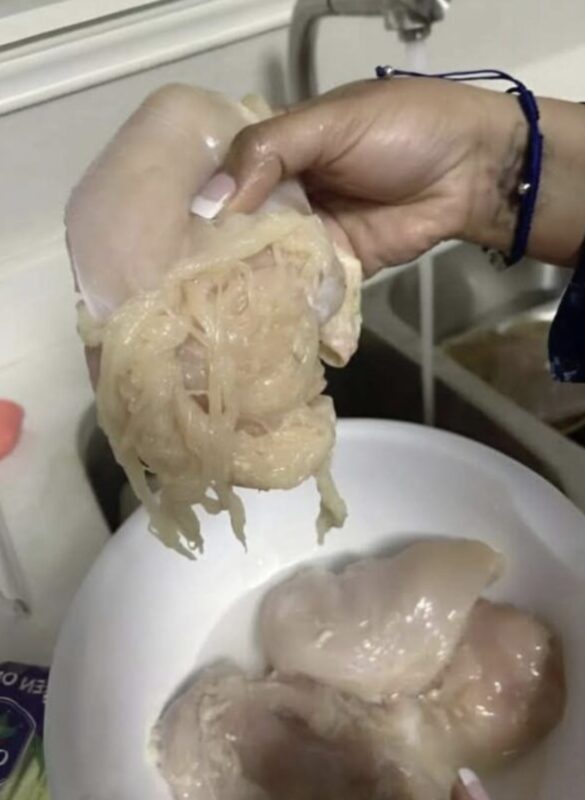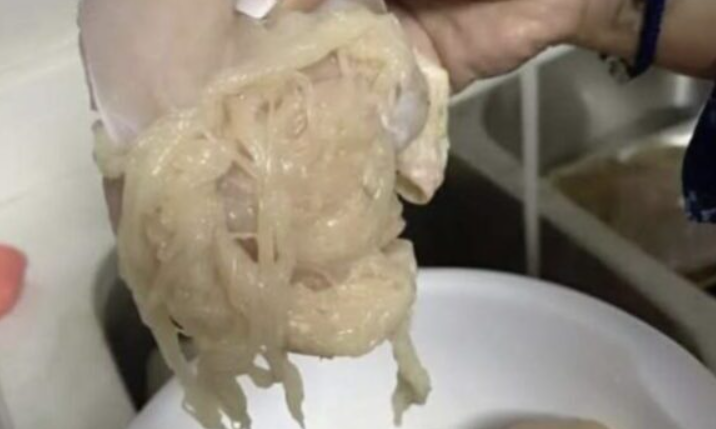We often take it for granted: walk into a grocery store, grab a pack of chicken breast, and prepare dinner—just like we’ve done countless times before.
But imagine a regular evening in the kitchen, cooking for your family, when something completely unexpected happens.
You open the packaging, rinse the chicken as usual. But the moment your fingers touch it, you sense something is off. The texture feels unfamiliar.
Instead of the firm, springy consistency you’re used to, the fillet begins to fall apart. Not from slicing—it separates on its own, into thin, string-like strands, almost like overcooked noodles.
It no longer feels like meat, but more like a soft, fibrous material with no strength to hold itself together.
This is exactly what one shopper experienced. Surprised and uneasy, they posted a photo of the “disintegrating chicken” online. The image quickly went viral.
Within hours, comments poured in: “I’ve had the same thing!”, “This looks wrong!”, “I wouldn’t eat that!” People were shocked—and understandably so.
But what’s really going on here? Why does raw chicken behave like it’s already shredded?
The phenomenon has a name: it’s called “spaghetti meat”—a term describing a muscle disorder increasingly found in mass-produced chicken breast.
While it may look like a case of spoiled meat or poor storage, the truth is deeper—and more concerning.

Veterinarians, food scientists, and agricultural researchers point to a single cause: the modern, industrial poultry production system.
Over the past few decades, chicken consumption worldwide has skyrocketed. In France alone, demand for chicken has doubled over the last 40 years.
Because breast meat is lean, high in protein, and easy to cook, it’s become the most sought-after part of the bird. In response, producers aim to generate larger, meatier breasts in less time.
This means breeding chickens from specialized genetic lines, chosen specifically for rapid growth and heavy muscle development.
In today’s commercial farming, a broiler chicken can reach up to 3 kilograms in just 47 days—a rate that is far from natural.
But this rapid pace comes at a cost. The muscles—especially the pectorals—often fail to develop properly. The tissue becomes loose, unstructured, and watery.
Muscle fibers begin to break down. That’s why the meat looks stringy, and falls apart before even hitting the pan. Instead of firm muscle, you’re left with something soft, spongy, and lacking density.
Studies have confirmed that spaghetti meat contains more water, less protein, and fewer essential nutrients compared to healthy chicken muscle.
From a food safety standpoint, it’s not deemed hazardous. But when it comes to quality, taste, and nutrition, the impact is undeniable.
Many consumers assume it’s spoiled. In truth, the condition originates long before processing—while the bird is still alive.
Excessive feeding, limited movement, and artificial lighting schedules disrupt the animal’s natural growth, leading to muscular abnormalities.
But this isn’t just about what’s on your plate—it’s also about the animals themselves. Chickens bred to grow unnaturally fast often suffer from pain, skeletal issues, and restricted mobility.
The oversized breast muscles can become a burden, making it hard for the birds to move or even stand properly—a life far from humane.
And so, the question arises: what are we really eating when we buy “cheap chicken breast”? The price tag may be low at the store—but what’s the hidden cost?
Behind a single fillet lies a global food system that too often overlooks natural development, nutrition, and animal welfare.
Spaghetti meat is more than a curiosity. It’s a red flag. A quiet warning on your dinner plate: it’s time to think critically, ask questions, and choose more responsibly.
Because even if it doesn’t smell bad—do we truly want this on our family’s table?
